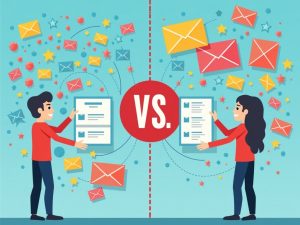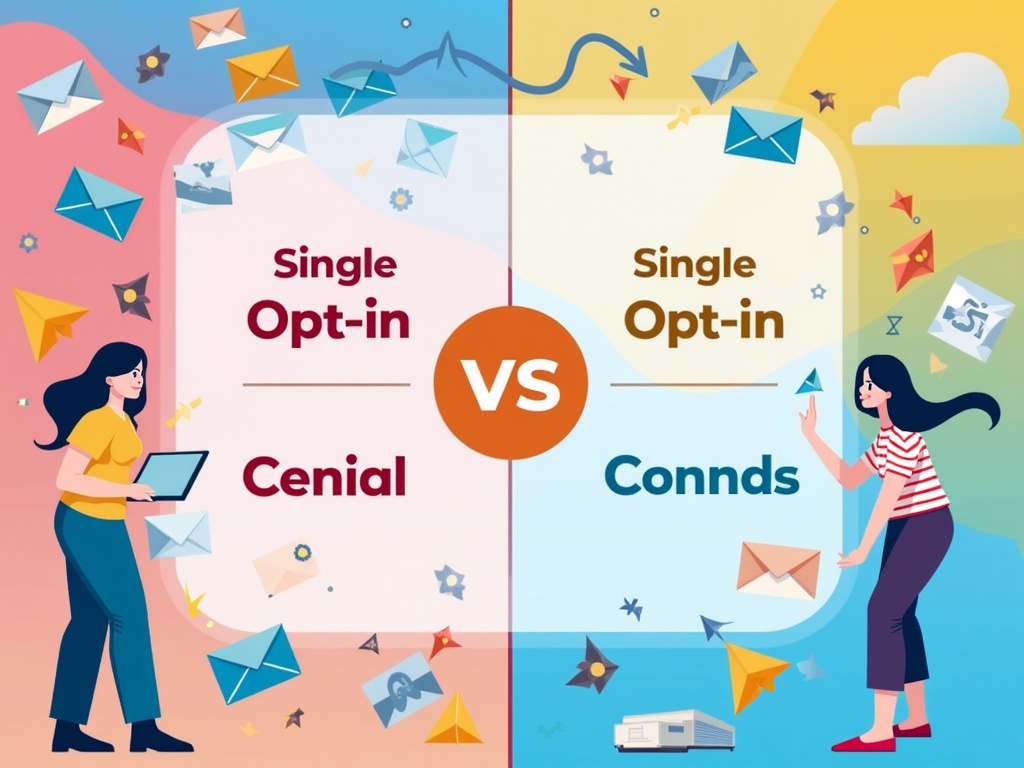Double Opt-In vs. Single Opt-In: Which is Right for Your Email List?
Imagine welcoming new subscribers to your email list like greeting guests at a party. Single opt-in is like leaving the front door wide open; anyone can wander in. Double opt-in, however, resembles a velvet rope – each guest needs to confirm their invitation before joining the festivities. Both approaches have their advocates, each with compelling arguments for their effectiveness. But which one truly benefits your email marketing strategy? Let's delve into the world of opt-in methods and uncover the secrets to building a thriving, engaged audience.
Understanding Opt-In Methods
Before diving into the pros and cons, let’s clearly define single opt-in and double opt-in. These methods dictate how subscribers are added to your email list after expressing interest.
Single Opt-In: Immediate Access
Single opt-in is the simpler of the two. A user provides their email address through a signup form – perhaps on your website, landing page, or social media. Immediately, they're added to your list and start receiving your emails. No further action is required from their end. It’s quick, easy, and provides immediate list growth.
Double Opt-In: Confirmed Consent
Double opt-in takes a more cautious approach. After a user submits their email address, they receive a confirmation email containing a link they must click. Only after clicking this link are they officially added to your list. This extra step ensures the subscriber genuinely wants to receive your emails and that the email address provided is valid.
Double Opt-In: A Deeper Dive
Double opt-in is a two-step process designed to verify the subscriber's intent. Here’s a closer look at how it works:
- User Submits Email: A potential subscriber enters their email address in your signup form.
- Confirmation Email Sent: Your system automatically sends a confirmation email to the provided address.
- Subscriber Confirms: The subscriber opens the email and clicks the confirmation link.
- Subscription Activated: Only after clicking the link is the subscriber added to your active email list.
Single Opt-In: A Closer Look
Single opt-in is a one-step process that allows immediate subscription. Let's see how this process unfolds:
- User Submits Email: A potential subscriber enters their email address in your signup form.
- Subscription Activated: The subscriber is immediately added to your active email list.
Double Opt-In vs. Single Opt-In: Pros and Cons
Now, let’s weigh the advantages and disadvantages of each method:
Double Opt-In: The Pros
- Higher Quality Leads: Subscribers who confirm their subscription are more likely to be genuinely interested in your content.
- Improved Email Deliverability: Confirming their email address reduces the chances of spam complaints, leading to better sender reputation and deliverability.
- Reduced Spam Traps: Double opt-in helps avoid accidentally adding spam traps (email addresses used to identify spammers) to your list.
- Enhanced Data Accuracy: The confirmation step ensures the email address provided is valid and active.
- Better Engagement Rates: Subscribers who actively choose to join your list are more likely to engage with your emails, leading to higher open and click-through rates.
- Compliance with Regulations: Double opt-in helps comply with regulations like GDPR, which require explicit consent for email marketing.
Double Opt-In: The Cons
- Slower List Growth: The extra step can deter some potential subscribers, resulting in a slower rate of list growth compared to single opt-in.
- Potential for Lost Subscribers: Some subscribers may forget to confirm or might not receive the confirmation email, leading to lost opportunities.
- Requires More Setup: Implementing double opt-in requires setting up automated confirmation emails and tracking confirmation rates.
Single Opt-In: The Pros
- Faster List Growth: The ease of subscribing leads to a quicker accumulation of subscribers.
- Simpler Implementation: Single opt-in is easier to set up, requiring less technical configuration.
- Captures Impulsive Sign-Ups: You can capture subscribers who sign up on a whim without requiring them to take further action.
Single Opt-In: The Cons
- Lower Quality Leads: A significant portion of your list may consist of uninterested or inactive subscribers.
- Poorer Email Deliverability: Higher spam complaint rates can negatively impact your sender reputation and deliverability.
- Increased Risk of Spam Traps: You're more likely to add spam traps to your list, which can damage your sender reputation.
- Higher Bounce Rates: Inaccurate or abandoned email addresses can lead to increased bounce rates, hurting your deliverability.
- Lower Engagement Rates: A larger proportion of your list may not engage with your emails, resulting in lower open and click-through rates.
- Potential Compliance Issues: Single opt-in may not meet the stringent consent requirements of regulations like GDPR.
When to Use Double Opt-In
Double opt-in is particularly beneficial in the following scenarios:
- When GDPR Compliance is Crucial: If your business operates in or targets individuals in the European Union, double opt-in is highly recommended to ensure compliance with GDPR's explicit consent requirements.
- When Email Deliverability is Paramount: If you prioritize a strong sender reputation and high deliverability rates, double opt-in helps minimize spam complaints and bounce rates.
- When Quality Leads are a Priority: If you value engagement and conversions over sheer list size, double opt-in ensures that your subscribers are genuinely interested in your content.
- When Dealing with Sensitive Information: If your emails contain sensitive information or require a high level of trust, double opt-in reinforces the subscriber's consent and intent.
When to Use Single Opt-In
While generally not recommended for long-term email marketing success, single opt-in might be considered in specific circumstances:
- When Rapid List Growth is Essential: If you need to quickly build a large list for a short-term campaign or promotion, single opt-in can provide a faster influx of subscribers. However, be prepared for lower engagement rates and potential deliverability issues.
- When Limited Resources are Available: If you have limited technical resources or budget for setting up automated confirmation emails, single opt-in offers a simpler and more straightforward solution.
The Impact on Email Deliverability
Email deliverability refers to your ability to successfully deliver emails to your subscribers' inboxes. Several factors influence deliverability, including your sender reputation, spam complaint rates, and bounce rates. Double opt-in significantly improves email deliverability by ensuring that your list consists of valid, engaged subscribers who have explicitly consented to receive your emails. This reduces the likelihood of spam complaints, minimizes bounce rates, and strengthens your sender reputation. Single opt-in, on the other hand, can negatively impact deliverability due to the potential for higher spam complaint rates, increased bounce rates, and the presence of spam traps on your list.
Legal Considerations and GDPR
The General Data Protection Regulation (GDPR) is a European Union law that governs the collection and processing of personal data, including email addresses. GDPR requires explicit consent for email marketing, meaning subscribers must actively and freely indicate their agreement to receive emails. Double opt-in is widely considered the gold standard for demonstrating GDPR compliance, as it provides clear evidence of the subscriber's consent. While single opt-in may technically be compliant in some cases, it's more challenging to prove that subscribers have genuinely and freely consented to receive your emails. For businesses operating in or targeting individuals in the EU, double opt-in is strongly recommended to avoid potential fines and legal issues.
Beyond the Basics: Optimizing Your Opt-In Process
Regardless of whether you choose single or double opt-in, optimizing your opt-in process is crucial for maximizing list growth and engagement. Here are some tips to consider:
- Make it Easy to Subscribe: Ensure your signup forms are easily accessible and user-friendly. Place them prominently on your website and social media channels.
- Offer a Compelling Incentive: Entice potential subscribers with a valuable offer, such as a free ebook, discount code, or exclusive content.
- Clearly State Your Value Proposition: Explain the benefits of subscribing to your email list and what kind of content subscribers can expect to receive.
- Optimize Your Confirmation Email (for Double Opt-In): Make your confirmation email clear, concise, and visually appealing. Include a prominent call-to-action that encourages subscribers to confirm their subscription.
- Segment Your List: Segment your list based on subscriber interests and demographics to send more targeted and relevant emails.
- Regularly Clean Your List: Remove inactive subscribers and invalid email addresses to improve your deliverability and engagement rates.
Tracking and Analyzing Your Results
To determine the effectiveness of your opt-in method and optimize your email marketing strategy, it's essential to track and analyze key metrics, such as:
- Subscription Rate: The percentage of website visitors who subscribe to your email list.
- Confirmation Rate (for Double Opt-In): The percentage of subscribers who confirm their subscription after receiving the confirmation email.
- Open Rate: The percentage of subscribers who open your emails.
- Click-Through Rate: The percentage of subscribers who click on links in your emails.
- Spam Complaint Rate: The percentage of subscribers who mark your emails as spam.
- Bounce Rate: The percentage of emails that cannot be delivered to subscribers' inboxes.
By monitoring these metrics, you can identify areas for improvement and make data-driven decisions to optimize your opt-in process and email marketing campaigns.
The Verdict: Quality Over Quantity
While single opt-in might seem appealing for its rapid list growth, the long-term benefits of double opt-in far outweigh the initial gains. Building a healthy, engaged email list is about quality, not quantity. Double opt-in ensures that your subscribers are genuinely interested in your content, leading to improved email deliverability, higher engagement rates, and stronger relationships with your audience. In today's digital landscape, where privacy and consent are paramount, double opt-in is the responsible and effective choice for building a thriving email marketing strategy.

